On this page: 3.8 Series 14.2 Series 1Series 1½Series 2Series 3Comments
A brief overview of the Jaguar E-Type, in photos.
| Open Two Seater | Fixed Head Coupe | Two Plus Two | |
|---|---|---|---|
| Series 1 3.8 Litre | |||
| 1961 to 1964 |
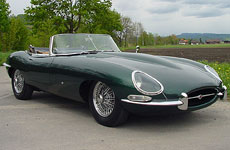  LHD Car Numbers: 875001 - 881887 RHD Car Numbers: 850001 - 850943 |
  LHD Car Numbers: 885001 - 890873 RHD Car Numbers: 860001 - 861799 | There was no 3.8 2+2. |
|
Pros: Purest style, 3.8 engine "more sporting", great performance, stunning looks Cons: Seats uncomfortable for some, early cars lack foot room, gearbox agricultural, demisting not great | |||
| Series 1 4.2 Litre | |||
| 1964 to 1967 |
 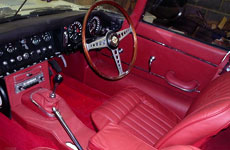 LHD Car Numbers: 1E10001 - 1E15888 RHD Car Numbers: 1E1001 - 1E1863 |
 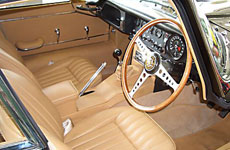 LHD Car Numbers: 1E30001 - 1E34249 RHD Car Numbers: 1E20001 - 1E21583 |
 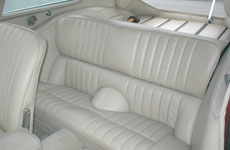 LHD Car Numbers: 1E75001 - 1E77644 RHD Car Numbers: 1E50001 - 1E50974 |
|
Pros: 4.2 engine more relaxed, better seats, better gearbox, 2+2 offers useful extra space, token rear seats, automatic Cons: Styling on 2+2 considered awkward, auto box not sporting, cooling sometimes marginal | |||
| Series 1½ | |||
| 1967 to 1968 |
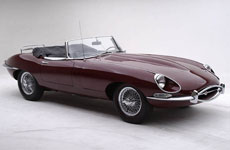 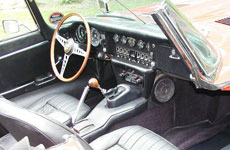 LHD Car Numbers: 1E15889 - 1E18368 RHD Car Numbers: 1E1864 - 1E2184 |
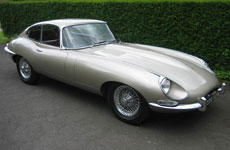  LHD Car Numbers: 1E34250 - 1E35815 RHD Car Numbers: 1E21584 - 1E21959 |
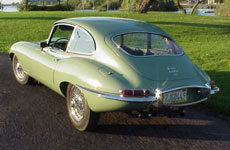  LHD Car Numbers: 1E77644 - 1E79222 RHD Car Numbers: 1E50975 - 1E51379 |
|
Pros: Open headlights improved lighting considerably, often considered ideal compromise between early and late cars Cons: Open headlights less stylish, later interiors lacked early charm | |||
| Series 2 | |||
| 1969 to 1971 |
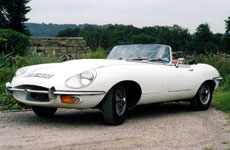 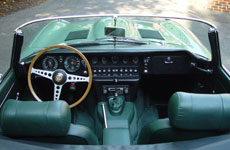 LHD Car Numbers: 1R7001 - 2R14854 RHD Car Numbers: 1R1001 - 2R1776 |
  LHD Car Numbers: 1R25001 - 2R28786 RHD Car Numbers: 1R20001 - 2R21071 |
 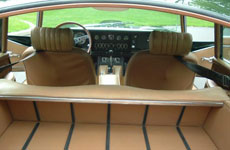 LHD Car Numbers: 1R40001 - 2R44287 RHD Car Numbers: 1R35001 - 2R36041 |
|
Pros: Much better cooling, safer interior, updated exterior, power steering option Cons: Styling a bit fussier, especially in rear, US spec cars slower with Stromberg carburetors | |||
| Series 3 | |||
| 1971 to 1974 |
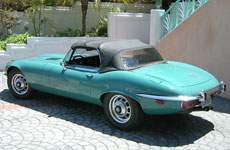 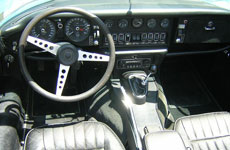 LHD Car Numbers: 1S20001 - 1S26120 RHD Car Numbers: 1S1001 - 1S2872 | There was no Series 3 Fixed Head Coupe. |
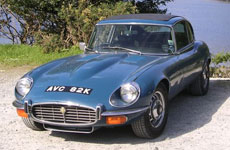  LHD Car Numbers: 1S70001 - 1S75183 RHD Car Numbers: 1S50001 - 1S52116 |
|
Pros: V12 engine powerful and smooth, more interior space in longer roadster Cons: Two-seat coupe dropped, V12 much more complex than six, larger and heavier | |||
You may leave a comment or question about this article:
2007-07-21 01:13:07 | Roger writes:
This is meant as a quickie guide for people confused about E-Types in their various guises. Comments or corrections welcome, just remember things move at a glacial pace around here!
2008-01-22 21:13:27 | Anonymous writes:
Is it possible that a '67 2+2 came with the 3 SU carbs, the S1 style dash, but open headlights with the wider mouth on the bonnet, or do I have a replacement bonnet along the way?
2008-03-13 12:04:30 | Tom McCann writes:
great web site for us etype lovers.
2008-07-01 18:37:33 | Charles writes:
Not to state the obvious, but the Series 3 was made between 1971 and 1974, not 1969 to 1971 . . .
2008-09-02 03:11:25 | Anonymous writes:
Does any one have any idea as to how many E types were Exported to India. And I read some where that a very few series 3 had a 4.2 engine- could this be ture .
2009-02-06 07:24:42 | Craig Balzer writes:
According to Philip Porter in “Jaguar E-Type: The Definitive History” (page 698-9) there were only two E-Types exported to India:
1 – in May of 1963 a Fixed Head Coupe went to Calcutta
1 – in 1969 another Fixed Head Coupe went to New Delhi
As to Series III E-type with the 4.2 liter 6-cylinder reports vary from 0 to 4 to 6. Porter reports on pg 477 of the above tome that there wee 3. Whatever the correct answer the 6-cylinder looked lost in the much wider-spread frame rails that accommodated the V12; again to quote Porter: “there was almost an embarrassment of room in comparison with the 5.3 liter power unit.”
Craig
2009-03-08 14:29:11 | Mike Price writes:
Great site, it was very nice looking at the over view of models when i realised that my car GFX 131D Pale primrose 2+2 was being used and it looks great. About to have the car back 2nd week march with its newly rebuilt engine, new frames and converted auto to manual.
2009-04-10 15:48:31 | Anonymous writes:
Does anyone know what number car was the last to have the exposed bonnet latches?
Thank you.
2009-09-26 09:25:35 | Johnny Saris writes:
The series 2, all the way to the right, what color is that?
2009-12-01 17:00:00 | Philippe Holland writes:
What a great site! Does anyone know the car number for the last flat floor series 1?
2010-08-07 17:55:29 | jagster writes:
Of course a number of 67 2+2's had triple SU carburetors, just like mine. I would love to find a 71 with the 6 cyl. engine. I like the flaired fenders, and they look like they could take more wheel and tire. Did you ever look at an E headon? The tires are lost under that body. Tires that small are known as weenies.
2010-11-21 10:40:37 | frank writes:
Does anyone know what the difference between the usa e types and the canadian e types?
2011-12-13 14:15:16 | Nick writes:
> Does anyone know what the difference between the usa e types and the canadian e types?
There was a handful of 1968 Canadian Series 1.5s shipped from the factory with triple SUs but most came with the US Federal spec Zenith Stromberg carburetors and attendant anti-smog equipment. All Canada- destined E-types were shipped with block heaters installed as standard equipment from mid-1968 on. Beyond that, no differences at all.
2012-01-17 22:58:39 | randy writes:
Does anyone know where I can get a replica or a copy of the window price sticker? Or at least to find out the price of car when new? thanks interested in a 1974 OTS.
2012-02-18 11:14:29 | Mateusz writes:
Hello. There was FHC in series III 2+2 :)
2012-08-24 21:59:15 | Armand writes:
On Series II 2+2, I see bonnets with side directional lights and some without. Mine does not. What is the difference? I am not sure mine is the original bonnet. Thanks.
2013-02-26 08:05:30 | Anonymous writes:
car with series 1. 5vin..looks to be a series 1.5 but ...had a series 2 style bonnet..signal lights side lights different opening of mouth and oval motif. i have checked Porter's book on jags and cannot see a mention of a series 1.5 with a series2 bonnet. ever heard of one? or is this car a series 1.5 with a new bonnet?
2013-11-22 17:13:08 | Midpac writes:
Gonna sound sacreligious but ... I have a 1974 OTS (my 10th and last XKE) which I love because of the wider doors, fender flares, etc, but I do not like the 12 cylinder ... too difficult to work on. I would like to know if anyone might know of the feasability / difficulty of replacing it with a 4.2 w/ triple SU setup ... same / different sub frames, etc ?
2014-01-31 23:01:36 | Anonymous writes:
is there any difference between s1 and s2 air-duct panels within the bonnet
2015-01-26 19:24:03 | docmill writes:
My 1970 has a plate in the drivers door stating 8-70 as manufaturing date and a number below that is 1R28540. It's supposed to be a 1970 xke 2+2, but my numbers don't fall in your categories as that. Something awry here?
2015-04-21 13:13:27 | Anonymous writes:
Which models EXACTLY were built or sold in 1967. I know I like (luv) the 67 Jag, confused which one. It's my dream car. ALL I remember as a kid is that it's front heavy. Like if a giant put his index finger on the hood, it would tip. The headlights are open not covered. Please help! Which one is it?
Thanks in advance for your input....
2015-06-04 14:53:29 | Dave writes:
I have a 1971 series II xke ots.
Vin # 2r13988
Chassis IR7001
How can I find the original color?
2016-05-25 07:23:27 | Chris writes:
I have just bought a 1968 etype vin 1E77479. Apparently it just comes in under the wire to be a series 1.
I want to restore it (or go broke trying) to it's original colour scheme. Try as I might I cannot seem to find out those details. It has a dark blue interior and Some fool gave it a grey paint job but I think I can see some blue around the edges...Opalescent silver blue maybe.
If I change the interior to red am I doing the car a disservice and lessening its value?
Any input appreciated. Thanks
2016-06-09 19:06:24 | nol writes:
Hello.
my car no is: 1E31208.
I am living in the Netherlands.
i am busy restoring my car.
my question about colours is: what colour does my engine head have because i am at that point now.And i see silver and i see gold. My car is a'65 FHC LHD 4.2.
Greetz Nol
noldegrooth@hetnet.nl
2016-07-14 02:00:36 | Dave Nichols writes:
I hav seen this question posted a few times, with no response. Does anyone know the total amount of open flat floor cars that were produced?
And also, would anyone know the highest vin number of the flat floors?
2016-10-29 19:15:45 | Kris writes:
Hi, does anybody know on S2 cars when the data plate was switched from the right side of the engine bay near the airfilter to left side next to the battery. Also when was the data plate itself changed to the later style. Many thanks Kris
2017-04-25 07:58:38 | JR writes:
Hi, can anyone tell me the difference between the series 3 E Type Roadsters that were made for the USA and Canadian market and the cars made for UK and Australia. I have a 73 V12 Roadster. Thanks, JR
2017-06-02 18:46:54 | Glynne writes:
Does any one know if the series 1 came with mats as well a carpet. I am building an 1/8 scale model and want to get it right
2019-02-02 18:07:15 | Lawrence writes:
As of January 1, 1968 American export E Types had twin Zenith-Stromberg carburettors and exhaust gas recirculation. However, some Series II cars in 1969, such as mine, left the factory with twin carbs but no exhaust gas recirculation. Does anyone know why? It is my understanding that the American regulations were federal, as in nationwide...so how come some Series II actually left the factory with no EGR? My car is Canadian, but rather than make assumptions I would like to know if someone knows for sure why it had no manifold between the rear exhaust and the inlet/intake manifold?... This doesn't seem to be rare. I have seen lots of cars with the factory blockage on the intake manifold. Thank you and I hope to hear from someone in-the-know.
2020-03-31 12:11:29 | daniel bartal writes:
Hello there, your site is great. I look for records of all E-TYPE chassis with as wide a detail as possible for each record (engine number, model, subtypes, steering side and more).
Searching in Excel or SPSS format. Thank you for your reference
Regards,
Daniel Bar-Tal
2022-02-22 10:34:27 | TOM writes:
Great site. My 1970 OTS LHD Series 2 had a Dunlop SP Sport Radial 185VR15 in the boot. Would that be the original spare? I'm in process with bringing this vehicle to survivor status and would like to know what type of tire (tyre) would be on a car 1R11625 of that era.
2024-10-10 12:38:27 | David Welch writes:
Just buying a Series 1 Pale Primrose 4.2 2+2 with original spare and wheel nut block. Looking forward to picking it up next week!!
2024-10-10 12:39:27 | David Welch writes:
1966 model, enjoyed the site write up, see engine and chassis numbers look chaotic


